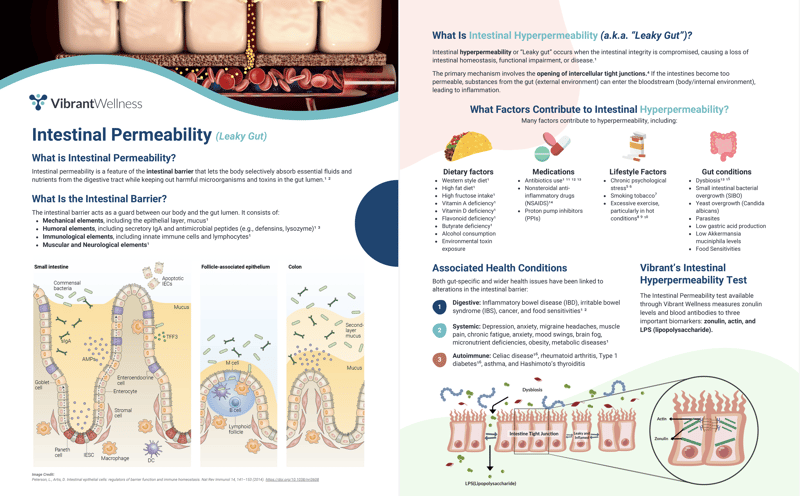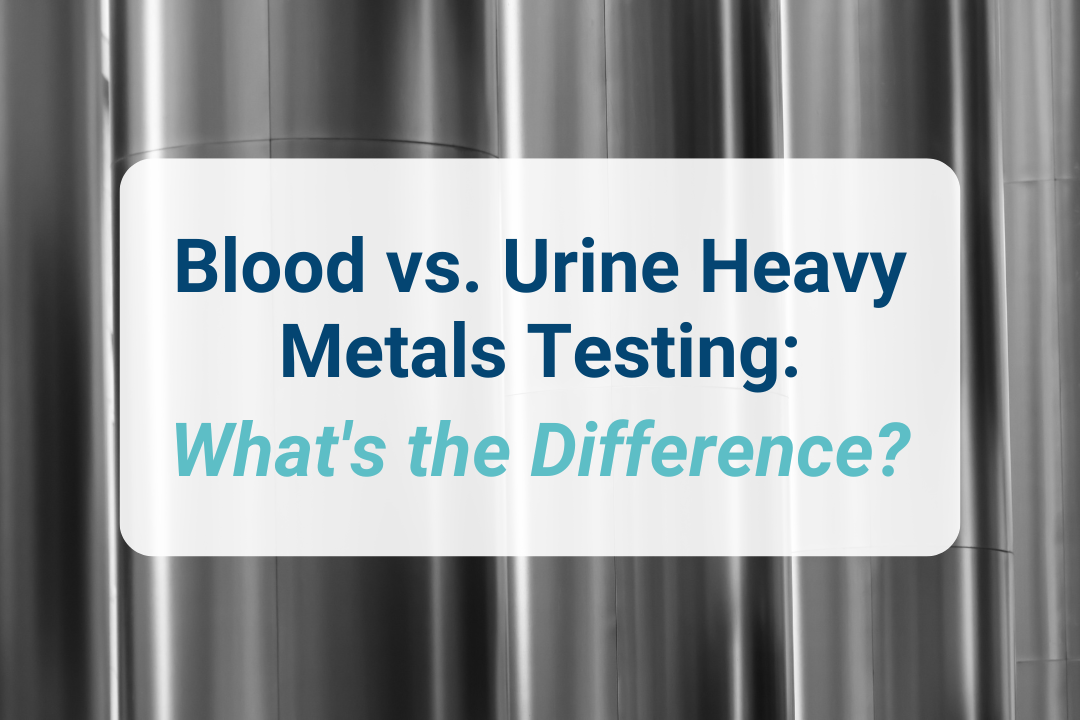The Role of Functional Testing in Diagnosing Leaky Gut
The gut barrier is a security checkpoint, allowing beneficial substances like micronutrients into the body and keeping harmful substances like toxins and bacteria out.
Some level of permeability is normal. But when the barrier becomes compromised, it causes increased intestinal permeability—also known as leaky gut.
Leaky gut causes chronic inflammation and is linked to several conditions, including celiac disease, IBS, Alzheimer’s, diabetes, and more.
Unfortunately, diagnosing leaky gut is difficult due to its broad range of symptoms, and its relationship with the diseases it can trigger isn’t well understood.
In this article, we’ll review the causes and effects of leaky gut, why it can be so challenging to diagnose, and why functional lab testing is a valuable diagnostic tool. You’ll also find precision testing recommendations to gain the most comprehensive view of leaky gut and resources to create personalized patient solutions.
Understanding Intestinal Hyperpermeability

The gut barrier is a semi-permeable membrane, meaning some substances can pass through while others can’t.
Intestinal permeability refers to the gut barrier allowing substances to pass through into the rest of the body. Some permeability is necessary, as there are substances that require entry, like nutrients and water.
But when the gut barrier is compromised, and tight junctions are damaged, harmful substances like bacteria and undigested food particles can get in.
This state of increased intestinal permeability is leaky gut.
Many factors can cause leaky gut, including:
- Chronic stress
- Poor diet
- High toxic burden
- Overuse of antibiotics
Undiagnosed leaky gut can wreak havoc on the body.
Milder symptoms of leaky gut include:
- Bloating
- Fatigue
- Cramps
- Food allergies and sensitivities
- Gas
- Headaches
- Autoimmune disorders like celiac
- Digestive issues
- Depression and mood disorders
- Diabetes
- Inflammatory bowel disease
- Multiple sclerosis
Challenges of Clinical Diagnosis
To maintain optimal health, diagnosing and addressing leaky gut is crucial. However, diagnosis is challenging based on symptoms alone.
This is because leaky gut tends to share symptoms with other conditions.
Additionally, even if you suspect leaky gut based on symptoms, without data, it’s difficult to determine which bacteria are at healthy levels and which are problematic.
Even when using testing to access data, not all testing methods are readily available or even reliable.
Shortcomings of Conventional Methods

Assessing Intestinal Permeability with the Ussing Chambers Technique
There are a few different conventional testing methods available to detect intestinal permeability. Ussing chambers, an ex vivo method, is considered the gold standard among conventional testing for the condition.
This method involves putting intestinal tissue through an Ussing chamber machine. Electrodes are then used to measure the potential difference in electrical charge. This helps determine how ions move across the tissue and how permeable the intestinal barrier is.
Although accurate, this method requires a sample of intestinal tissue. And this can only be retrieved from a patient through surgery. Researchers may approach patients already undergoing surgery and remove intestinal tissue to contribute by providing sample tissue.
But otherwise, this method is not typically used amongst the general population. Thus, the Ussing chamber method isn’t a viable option for most patients with intestinal permeability.
Assessing Intestinal Permeability via the Transcellular Route
A much more common conventional testing method involves giving patients different sugars orally and measuring their levels in urine. Some sugars are smaller than others and get further through the barrier. Thus, their levels should indicate intestinal permeability in different areas of the gut barrier. The most common of these tests measures the ratio of the synthetic sugar lactulose to the sugar alcohol mannitol.
With this test, patients are given a solution containing both lactulose and mannitol. Lactulose is a larger molecule that generally cannot get through the gut barrier. Mannitol is a smaller, easily absorbed molecule. Urine samples are collected over a certain period, and the lactulose-to-mannitol ratio is measured. Increased levels of lactulose should indicate increased intestinal permeability.
Measuring levels of these substances is thought to indicate small intestinal permeability. But in reality, the evidence supporting this theory is scarce, and the validity of the test is uncertain.
Additionally, these types of tests can be tedious, poorly reproducible, and time-consuming.
Assessing Intestinal Permeability with Isolated Serum Markers
Finally, there are conventional testing methods that detect individual markers of intestinal permeability. One of these is serum zonulin.
However, whether or not these individual markers accurately indicate leaky is controversial.
Let’s take zonulin, for example. Although zonulin is a validated marker for intestinal hyperpermeability, serum zonulin may not be the most accurate indicator of the condition.
Fecal zonulin—used in functional testing like the Gut Zoomer—is a more accurate marker of intestinal hyperpermeability. In contrast, increased levels of serum zonulin are more commonly seen in other conditions like food allergies and gastrointestinal infection.
Lastly, even with a validated marker, testing solely for isolated markers may not provide sufficient information.
By comparison, the Vibrant Wellness Gut Zoomer tests for hundreds of microbes, 15 digestive and inflammatory markers, and 11 additional fecal markers.
Advantages of Functional Lab Testing
 The multifaceted effects of leaky gut require a holistic approach to diagnosis.
The multifaceted effects of leaky gut require a holistic approach to diagnosis.
That means testing for permeability and other symptoms that may indicate leaky gut—dysbiosis, food reactions, malabsorption, and inflammation.
Benefits of functional testing include:
- It’s simple and non-invasive
- It’s comprehensive—detects permeability as well as accompanying symptoms
- It uses multiple forms of technology, not just one: microarray, RTPCR, sandwich ELISA, LCMS, and GCMS technologies
- It provides enhanced sensitivity and specificity
- It tests for validated markers
Functional lab testing paints a complete picture of your patient’s gut function and related conditions rather than only testing for permeability or isolated markers.
This provides insights into possible causes and effects as well as the current condition of the gut.
Critically, it will assess the presence of intestinal hyperpermeability and provide the context in which it exists.
You’ll also gain essential insights into nutrient deficiencies, specific species of pathogenic bacteria, and food reactions, to help create treatment plans tailored to your patient’s unique condition.
Precision Testing Options for Leaky Gut
Gut Zoomer
The Gut Zoomer assesses bacteria, yeast, viruses, and parasites in the gut microbiome alongside relevant digestive and inflammatory markers. It features three sections: commensal microbes, digestive markers, and pathogens.
This panel measures:
- Over 170 species of bacteria
- 67 pathogenic microorganisms
- Functional markers of digestion and inflammation
- The entirety of genetic information (DNA) from all microorganisms tested

The panel gives an in-depth view of common gut imbalances such as:
- Loss of beneficial organisms
- Excessive growth of potentially harmful organisms
- Loss of overall microbial diversity
The Gut Zoomer also highlights low levels of probiotic organisms so you can create personalized probiotic recommendations for your patients.
This test is unique in that it helps detect dysbiosis and inflammation in the gut, both signs of leaky gut. You’ll see which specific species of bacteria are problematic and which beneficial bacteria are lacking.
Methodology
The Gut Zoomer utilizes proprietary silicon microarray technology. This helps reduce error and enhance specificity and sensitivity.
Using the microarray hybridization platform and complementary base pairs, the panel can measure the entire DNA from all microorganisms.
This dramatically expands the amount of genetic material that can be identified. The Gut Zoomer can thus detect pathogens with 96% specificity and 100% sensitivity.
Wheat Zoomer
The Wheat Zoomer assesses wheat sensitivity, intestinal barrier permeability, and early and sensitive detection of celiac disease.
This panel measures:
- IgE, IgA, and IgG antibodies
- Celiac markers
- Intestinal permeability
The Wheat Zoomer helps diagnose leaky gut by detecting the full spectrum of wheat reactions, including allergy, sensitivity, and celiac disease (autoimmunity). Wheat sensitivity could be a sign of leaky gut as leaky gut can trigger new food sensitives. Celiac disease also often accompanies intestinal damage and leaky gut.

This panel is unique because it provides early celiac detection by testing for transglutaminase (tTG/DGP) IgA and IgG antibodies. It also tests for immune reactions to the entire wheat stalk, not just gluten.
To detect leaky gut, the test includes an intestinal hyperpermeability panel. The panel tests for markers like zonulin and anti-zonulin, anti-actin, and anti-LPS antibodies.
Methodology
By testing at the peptide level, the Wheat Zoomer eliminates common drawbacks of other food sensitivity tests, such as:
- Inaccurate results due to water-soluble proteins and whole protein limitations
- Extract cross-reactivity
- Cooked vs. raw effects on the breakdown of proteins
This panel has a 99% specificity and 100% sensitivity rate to identify false negatives and false positives accurately.
Food Sensitivity Profiles
The Food Sensitivity Profiles detect sensitivity to 209 common foods in the Western diet and food additives such as preservatives, artificial sweeteners, emulsifiers, food dyes, and pesticides.
These profiles measure:
- IgA and IgG antibodies
- IgG4 and C3D antibodies
- Sensitivity to 209 different foods
- Whole water-soluble proteins
This is relevant when considering leaky gut because the condition can trigger food and food additive sensitivity development and vice versa.

When the gut barrier is compromised, undigested food particles can get through to the body, causing sensitization to particular foods.
Thus, food sensitivity testing can give insights into the state of the gut barrier.
Methodology
The Food Sensitivity panels use peptide microarray technology to detect antibody-antigen binding.
This method enhances sensitivity and specificity with a 95-100% accuracy rate.
The panels use raw, organic, water-soluble, FDA-approved antigens at the whole protein level. Using raw antigens helps control for differences in various cooking methods and is more reproducible.
Testing at the whole protein level can also help identify potential gastrointestinal imbalances when there are many positive food reactions.
Food Zoomers
Food Zoomers test for food sensitivities, allergies, and autoimmune reactions to the most common food allergens in the western diet.
Vibrant Wellness offers the following comprehensive Food Zoomers:
- Dairy
- Eggs
- Fish
- Crustacean shellfish
- Tree nuts
- Peanuts
- Wheat
- Lectin
- Grain
- Mammalian milk
- Soy

Like sensitivities, food allergies can be a sign of leaky gut. Food allergens can worsen intestinal permeability, allowing antigens to penetrate the intestinal barrier and stimulate the submucosal immune system. This causes an inflammatory reaction that further degrades the epithelial barrier, leading to a cycle of intestinal damage.
These panels measure:
- IgA, IgG, and IgE autoantibodies
- Immune reactivity to small, 2-dimensional peptides generated from whole protein digestion
Methodology
Food Zoomers help identify antibodies to peptides using a peptides-based array designed to detect autoimmune reactions to foods.
Testing at the peptide level can minimize common drawbacks of other food sensitivity tests.
The Food Zoomer panels have a 99% specificity and 100% sensitivity rate, identifying false negatives and false positives accurately.
Micronutrients
The Micronutrient Panel measures both intra- and extracellular nutrient status of common vitamins, minerals, co-factors, amino acids, essential fatty acids, and more.
The panel measures:
- Direct levels of extra- and intracellular micronutrients
- Micronutrient levels in red and white blood cells
- The cellular function of micronutrients in our blood

Testing micronutrients can help diagnose leaky gut because nutrient malabsorption is a strong sign of increased intestinal permeability.
Intestinal hyperpermeability and malabsorption often accompany each other due to inflamed intestinal epithelial cells. Thus, if a patient is deficient in various nutrients, it can likely be due to leaky gut.
Methodology
The blood sample taken for the Micronutrient panel is spun down to separate serum and red and white blood cells. White blood cell (WBC) counts are taken on an automated cell counter, and intracellular WBC levels are normalized to the WBC count.
All three subsets are processed separately to isolate the micronutrients for injection into mass spectrometry.
The Micronutrient panel then uses mass spectrometry to measure levels of micronutrients. This method enhances detection, accuracy, and reproducibility.
Additional Resources
In conjunction with precision testing, the resources below can help you create personalized protocols to address leaky gut.
Intestinal Permeability Handout

Reference the Intestinal Permeability handout for information on the nature of leaky gut, contributing factors, associated conditions, and the Wheat Zoomer’s intestinal hyperpermeability panel.
Gut Health Food Plan
The Gut Health Food Plan provides a step-by-step nutrition plan to heal chronic gut inflammation and resolve symptoms.
Leaky Gut Protocol
Use the Introduction to Intestinal Permeability for a patient-friendly, four-step treatment plan to resolve leaky gut. You’ll also find an in-depth analysis of key leaky gut markers.
Clinical Webinar: Optimizing Gut Health to Support Detoxification
Watch this clinical webinar recording to learn how optimizing gut health can aid in detoxification and how to identify toxicity using the Gut Zoomer.
Increased intestinal permeability is a complex phenomenon that can impact various body mechanisms, including nutrient absorption, digestion, and food reactions.
Diagnosing leaky gut based on symptoms alone often falls short due to a lack of data. Additionally, conventional methods that test only for permeability using isolated markers often don’t provide enough information for a reliable diagnosis.
With precision lab tests like the Gut Zoomer, Wheat Zoomer, Micronutrient panel, and Food Sensitivity and Food Zoomer panels, you can accurately assess intestinal permeability status and the related causes and side effects.
Finally, by combining precision testing with gut health resources, you can create truly personalized solutions for patients to resolve leaky gut, and improve outcomes.
Regulatory Statement:
The general wellness test intended uses relate to sustaining or offering general improvement to functions associated with a general state of health while making reference to diseases or conditions. This test has been laboratory developed and its performance characteristics determined by Vibrant America LLC and Vibrant Genomics, a CLIA-certified and CAP-accredited laboratory performing the test. The lab tests referenced have not been cleared or approved by the U.S. Food and Drug Administration (FDA). Although FDA does not currently clear or approve laboratory-developed tests in the U.S., certification of the laboratory is required under CLIA to ensure the quality and validity of the test
 By
By




